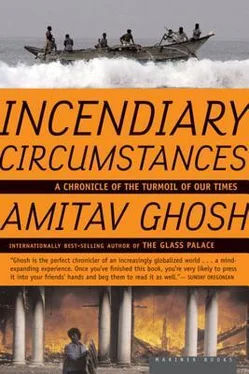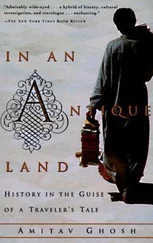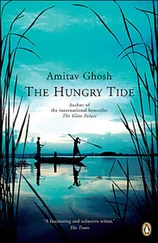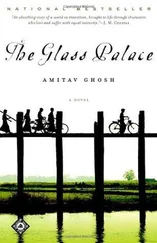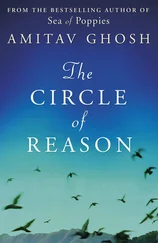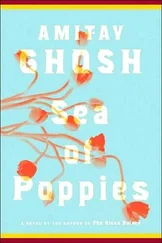Laughing at my astonishment, she said, "Didn't I tell you? It's a benefit for the Tibetan cause."
More astonished still, I said, "Which Tibetan cause?"
"The Tibetan cause," someone said vaguely, picking at a curl of something indeterminately vegetal that had been carved into a flower shape. It was explained to me then that the benefit was being hosted by a celebrated Hollywood star, a young actor who, having risen to fame through his portrayal of the initiation rites of an American officer, had afterward converted to Tibetan Buddhism and found so much fulfillment in it he was reported to have sworn that he would put Tibet on the world map, make it a household word in the United States, like Maalox or Lysol.
"The odd thing is," said my friend, "that he really is very sincere about this; he really isn't like those radical chic cynics of the sixties and seventies. He's not an intellectual, and he probably doesn't know much about Tibet, but he wants to do what little he can. They have to raise money for their schools and so on, and the truth is that no one in New York is going to reach into their pockets unless they can sit at dinner with rock stars' ex-wives. It's not his fault. He's probably doing what they want him to do."
I looked at the Tibetan monk again. He was being talked to by an improbably distinguished man in a dinner jacket. He caught my eye and nodded, smiling, as he bit into a dumpling.
Suddenly I remembered what the dumpling was. It was a Tibetan mo-mo, but stuffed with salmon and asparagus and such-like instead of the usual bits of pork and fat. I sat back to marvel at the one dumpling left on my plate. It seemed a historic bit of food: one of the first genuine morsels of Tibetan nouvelle cuisine.
The last time I'd eaten a mo-mo was as an undergraduate, in Delhi.
A community of Tibetan refugees had built shacks along the Grand Trunk Road, not far from the university. The shacks were fragile but tenacious, built out of bits of wood, tin, and corrugated iron. During the monsoons they would cover the roofs with sheets of tarpaulin and plastic and weigh them down with bricks and stones. Often the bricks would be washed away and the sheets of plastic would be left flapping in the wind like gigantic prayer flags. Some of the refugees served mo-mos, noodles, and chhang, the milky Tibetan rice beer, on tables they had knocked together out of discarded crates. Their food was very popular among the drivers who frequented that part of the Grand Trunk Road.
In the university, it was something of a ritual to go to these shacks after an examination. We would drink huge quantities of chhang —it was very diluted, so you had to drink jugs of it — and eat noodle soup and mo-mos. The mo-mos were very simple there: bits of gristle and meat wrapped and boiled in thick skins of flour. They tasted of very little until you dipped them into the red sauce that came with them.
The food was cooked and served by elderly Tibetans; the young people were usually away, working. Communicating with them wasn't easy, for the older people rarely knew any but the most functional Hindi.
As we drank our jugs of chhang, a fog of mystery would descend on the windy, lamp-lit interiors of the shacks. We would look at the ruddy, weathered faces of the women as they filled our jugs out of the rusty oil drums in which they brewed the beer and try to imagine the journey they had made: from their chilly, thin-aired plateau 15,000 feet above sea level, across the passes of the high Himalayas, down into that steamy slum, floating on a bog of refuse and oil slicks on the outskirts of Delhi.
Everyone who went there got drunk. You couldn't help doing so — it was hard to be in the presence of so terrible a displacement.
It was an unlikely place, but Tibetans seem to have a talent for surviving on unlikely terrain. Ever since the Chinese invasion of Tibet, dozens of colonies of Tibetan refugees have sprung up all over India. Many of them run thriving businesses in woolen goods, often in the most unexpected places. In Trivandrum, near the southernmost tip of India, where the temperature rarely drops below eighty degrees Fahrenheit and people either wear the thinnest of cottons or go bare-bodied, there are a number of Tibetan stalls in the marketplace, all piled high with woolen scarves and sweaters. They always seem to have more customers than they can handle.
Once, going past the Jama Masjid in Delhi in a bus on a scorching June day, I noticed a Tibetan stall tucked in between the sugarcane juice vendors. Two middle-aged women dressed in heavy Tibetan bakus were sitting in it, knitting. The stall was stacked with the usual brightly colored woolen goods. The women were smiling cheerfully as they bargained with their customers in sign language and broken Hindi. A small crowd had gathered around them, as though in tribute to their courage and resilience.
I found myself looking around the restaurant, involuntarily, for another Indian face, someone who had been properly invited, unlike me. I suppose I was looking for some acknowledgment, not of a debt but of a shared history, a gesture toward those hundreds of sweaters in Trivandrum. I couldn't see any. (Later someone said they'd seen a woman in a sari, but they couldn't be sure; it might have been a Somali robe — this was, after all, New York.)
When I next caught the monk's eye, his smile seemed a little guilty: the hospitality of a poor nation must have seemed dispensable compared to the charity of a rich one. Or perhaps he was merely bewildered. It cannot be easy to celebrate the commodification of one's own suffering.
But I couldn't help feeling that if the lama, like the actor, really wanted to make Tibet a household word in the Western world, he wasn't setting about it the right way. He'd probably have done better if he'd turned it into an acronym, like TriBeCa or ComSubPac. And sold the rights to it to a line of detergents or even perhaps a breakfast cereal.
TiBet (where the Cause is): doesn't sound too bad — marketable, even.
IT BECOMES IMPOSSIBLE to ignore the Four Corners once Route 160 enters Colorado's Montezuma County: chevroned signposts spring regularly out of the sand and scrub, urging you toward it. Even if you had never heard of it before, did not know that it is the only point in the USA where four states meet, you are soon curious; it begins to seem like a major station, a Golgotha or Gethsemane, on this well-worn tourist pilgrimage.
The size and sleekness of the trailers and traveling homes heading toward it are eloquent of its significance. These are not the trailers you have grown accustomed to seeing in small towns in the South and Midwest — those shiny aluminum goldfish bowls that sit parked in back yards until the ballgame in the next town, when they get hitched onto pickup trucks and towed out to the ballpark to serve as adjuncts for tailgate parties. Not these; these are no ordinary trailers, they are recreational vehicles (RVs) — if not quite palaces, then certainly midtown condos, on wheels.
You get a real idea of how big they are only when you try to pass one on a two-lane road in a Honda Civic that lost its fifth gear 8000 miles ago. Before you are past the master bedroom, are barely abreast of the breakfast nook, that blind curve that seemed so far away when you decided to make a break for it is suddenly right upon you.
It teaches you respect.
Their owners' imaginations are the only limits on the luxuries those RVs may be made to contain.
Once, on a desolate stretch of road in the deserts of western Utah, I watched an RV pull into a sand-blown rest area right beside my battered Honda Civic. It was almost as long as a supermarket truck, and the air around it was sharp with the smell of its newness. A woman with white curly hair stuck her head out of a window, tried the air, and said something cheerful to someone inside, over the hum of the air conditioning. A moment later the door opened, a flight of stairs clicked magically into place under it, and she stepped out, throwing a wave and a cheery "How you doin'?" in my direction. She was carrying a couple of chairs and a rack of magazines. Her husband climbed out too, and in companionable silence they pulled an awning out of the side of the vehicle and unrolled a ten-foot length of artificial turf under it. She waved again, after the chair, the magazine rack, a pot of geraniums, and a vase with an ikebanaed orchid had been properly arranged on the patch of green. "I call this my bower," she said, smiling. "Join us for cakes and coffee?"
Читать дальше
